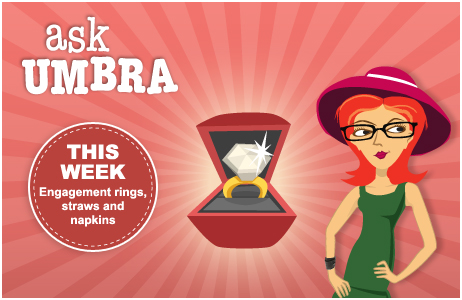Send your question to Umbra!
Q. Dear Umbra,
My boyfriend and I are talking seriously about marriage, and he knows I don’t want a diamond ring (at least not a new one) because of the social and environmental impacts. You addressed this topic in 2003, saying the only good options were no ring or a used ring. I’m wondering if, in the past seven years of “green” innovation, there might be other options to consider.
Thanks,
Sarah
Washington, D.C.
A. Dearest Sarah,
You know, I just can’t get that song out of my head. If you liked it then you shoulda put a ring on it/If you liked it then you shoulda put a ring on it … OK, that’s actually the only part I know, so it’s just running on a mental loop as I write this.
Obviously, your boyfriend cares a great deal about your finger because he does, in fact, want to adorn it with a ring. And while, sure, the most eco-friendly options may be to have no ring at all or opt for a second-hand band, they aren’t the only ways to celebrate your engagement in a socially and environmentally responsible fashion. Maybe it’s just because I smell Valentine’s Day in the air, but I think there’s something lovely about what the ring represents, despite its roots as a sort of down payment.
A couple of things to look for if you’re going the new ring route: recycled metals and responsible diamond sourcing. I won’t take you through the whole depressing diatribe — check out No Dirty Gold’s site or DiamondFacts.org for more info. But I will say mining metals is a dirty business; it takes 20 tons of mining waste to produce just one gold band. And the cyanide used to extract gold from ore is highly toxic. Plus, the unethical treatment of diamond mine workers, as well as the horror of conflict or blood diamonds, is a major issue. You need to get the real down-low on where your diamond is sourced — take a look at Brilliant Earth’s Conflict Free Diamond Buying Guide, which includes a handy list of questions to ask a jeweler. Other companies known for adhering to ethical social and environmental standards include GreenKarat and Ingle & Rhode.
You could always go a completely untraditional route with a wooden ring made from salvaged wood, a tattooed band, or perhaps a Chia Pet-esque ring, though a moss-growing ring probably won’t last as long as your love.
Matrimonially,
Umbra
P.S. When it comes time to plan your wedding, check out our how-to guide for no- (or low-) impact nuptials.
Q. Dear Umbra,
I enjoy drinking out of straws. Is this putting me at risk for BPA contamination? How awful of a habit is this for the environment? Are straws recyclable?
Thank you,
WM
Portland, Ore.
A. Dearest WM,
Don’t be ashamed — I also enjoy drinking straws. But plain and simple: Plastic straws suck.
While they’re not likely to leach toxic chemicals like BPA and may be recyclable (check with your local recycling program to find out), most disposable straws are made from polypropylene — a product of the nasty petrochemical industry. And the plastic from the thousands of straws littering landfills will never fully break down, so ask yourself: Is it worth it to enjoy drinking one beverage from a plastic straw, knowing that the plastic will in fact outlive us all? Kind of dramatic, no?
The best solution is, of course, no straw at all — just suck it up, tilt that glass, and pour the beverage directly into your mouth. Did that bring a little tear to your eye? There, there. Don’t cry. The good news is that you don’t have to forgo the simple pleasure of consuming a cold beverage through a straw in order to honor your commitment to the planet. Try opting for a reusable straw made from stainless steel or glass instead. Just imagine how impressed your dinner date will be when you turn down the waiter’s disposable straw and whip out your own shiny reusable one. The answer is very.
Slurpily,
Umbra
Q. Dear Umbra,
I have two small children, who tend to go through a lot of napkins at meal time. Is it better to use recycled paper napkins, or to switch to cloth napkins that I can wash with the rest of their never-ending laundry? They typically go through 1–2 napkins at each meal and snack time — so about 5–10 each per day. Thanks!
Lucy M.
Round Rock, Texas
A. Dearest Lucy,
Questions like this really do warm my heart. Granted, this falls under the small choices category, one I often tell people not to sweat. But you’re essentially asking: Should I opt for the green choice or the green one?
The fact is either way you go — recycled or reusable — you’re being a more conscious consumer by taking a big step up from choosing disposable napkins. Disposables are made from virgin fiber and bleached with chlorine (which releases carcinogenic dioxins during manufacture — ick). Why buy bright white napkins when your kids are going to soil them soon anyway? If every household in the United States replaced just one package of virgin fiber napkins with 100% recycled ones, we could keep 1 million trees standing.
That said, let’s take a look at reusable cloth napkins — the optimal choice, in my opinion, if you pick the right ones and care for them in the most eco-friendly fashion. Opting for secondhand napkins or ones made from reclaimed material — or getting crafty and making your own — conserves new resources. If you’d rather buy new ones, choose organic cotton or hemp.
Odds are that your kids will get multiple uses out of one cloth napkin before it’s washed, so you won’t be adding mountains of dirty laundry. When it is time for a cleaning, launder the napkins in cold water and NPE-free detergent, and skip the dryer sheets. Skip the dryer, for that matter, and hang your napkins on a clothesline or indoor drying rack. And cut your spaghetti sauce servings down to once a week.
Wipily,
Umbra



